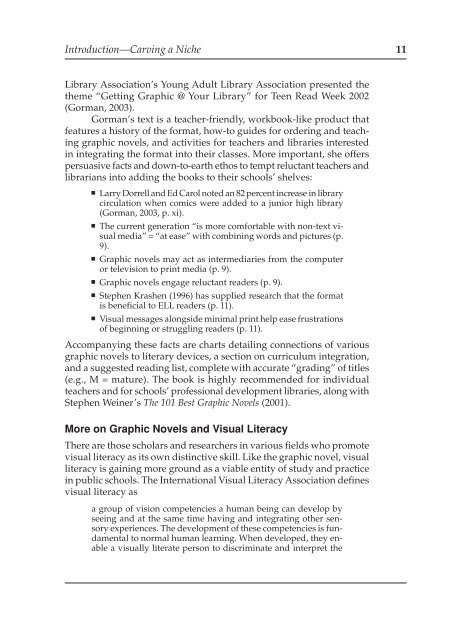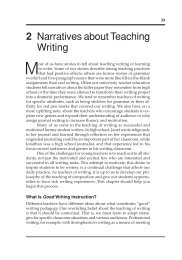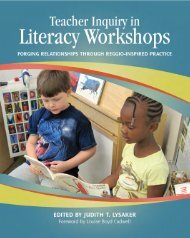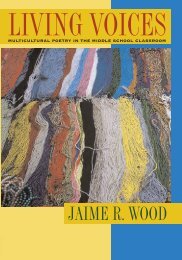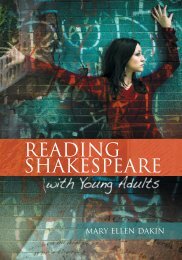Graphic novel Spread - National Council of Teachers of English
Graphic novel Spread - National Council of Teachers of English
Graphic novel Spread - National Council of Teachers of English
- No tags were found...
Create successful ePaper yourself
Turn your PDF publications into a flip-book with our unique Google optimized e-Paper software.
Introduction—Carving a Niche 11<br />
Library Association’s Young Adult Library Association presented the<br />
theme “Getting <strong>Graphic</strong> @ Your Library” for Teen Read Week 2002<br />
(Gorman, 2003).<br />
Gorman’s text is a teacher-friendly, workbook-like product that<br />
features a history <strong>of</strong> the format, how-to guides for ordering and teaching<br />
graphic <strong>novel</strong>s, and activities for teachers and libraries interested<br />
in integrating the format into their classes. More important, she <strong>of</strong>fers<br />
persuasive facts and down-to-earth ethos to tempt reluctant teachers and<br />
librarians into adding the books to their schools’ shelves:<br />
Larry Dorrell and Ed Carol noted an 82 percent increase in library<br />
circulation when comics were added to a junior high library<br />
(Gorman, 2003, p. xi).<br />
The current generation “is more comfortable with non-text visual<br />
media” = “at ease” with combining words and pictures (p.<br />
9).<br />
<strong>Graphic</strong> <strong>novel</strong>s may act as intermediaries from the computer<br />
or television to print media (p. 9).<br />
<strong>Graphic</strong> <strong>novel</strong>s engage reluctant readers (p. 9).<br />
Stephen Krashen (1996) has supplied research that the format<br />
is beneficial to ELL readers (p. 11).<br />
Visual messages alongside minimal print help ease frustrations<br />
<strong>of</strong> beginning or struggling readers (p. 11).<br />
Accompanying these facts are charts detailing connections <strong>of</strong> various<br />
graphic <strong>novel</strong>s to literary devices, a section on curriculum integration,<br />
and a suggested reading list, complete with accurate “grading” <strong>of</strong> titles<br />
(e.g., M = mature). The book is highly recommended for individual<br />
teachers and for schools’ pr<strong>of</strong>essional development libraries, along with<br />
Stephen Weiner’s The 101 Best <strong>Graphic</strong> Novels (2001).<br />
More on <strong>Graphic</strong> Novels and Visual Literacy<br />
There are those scholars and researchers in various fields who promote<br />
visual literacy as its own distinctive skill. Like the graphic <strong>novel</strong>, visual<br />
literacy is gaining more ground as a viable entity <strong>of</strong> study and practice<br />
in public schools. The International Visual Literacy Association defines<br />
visual literacy as<br />
a group <strong>of</strong> vision competencies a human being can develop by<br />
seeing and at the same time having and integrating other sensory<br />
experiences. The development <strong>of</strong> these competencies is fundamental<br />
to normal human learning. When developed, they enable<br />
a visually literate person to discriminate and interpret the


